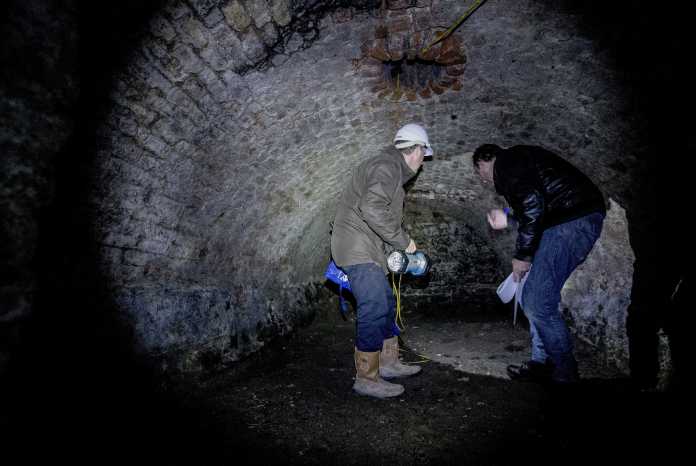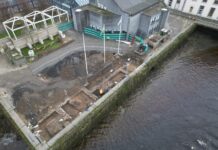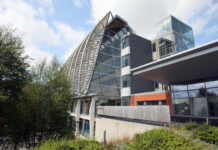
Limerick Post reporter Alan Jacques shines a light on hidden Limerick as he reaches new depths to explore the tunnels beneath the city centre.
by Alan Jacques

AFTER a recent visit to the council’s underground bunker, my editor was a little perturbed when I announced that I was going below ground once more, this time to check out the tunnels beneath the city.
“Is that black dog at you again?” he teased.
Yes, who knew it, but it turns out I have a thing for spending time in dark subterranean hidey-holes. I must have been a bat in a previous incarnation!
Over the years I have heard mythical tales of tunnels under the city serving as escape routes from popular hostelries during raucous all-night drinking sessions when the guards came a-knocking. I heard drunken stories about a magical labyrinth of tunnels beneath the city, which sounded like something out of ‘The Phantom of the Opera’.
As it turns out, a vast system of tunnels incorporating sewers and service bays were constructed in Limerick in the late eighteenth century, when the Georgian part of the city was being built during a major construction boom. It is said that there was a time when you could travel from one part of Limerick City to another down as far as the River Shannon using these underground passages.
Interestingly, when Limerick’s streets were renamed in the early twentieth century after the Irish Free State came into being, the sewers underneath still kept their lofty British monikers. So, while the sun shone down on O’Connell Street on a beautiful summer’s day, the faecal matter was stinking things up directly beneath in George’s Street, named after King George III.

Sadly, the council has since concreted many of these tunnels up, with only a few of the curious burrows still accessible today.
The Limerick Post recently met up with project manager for the Regeneration programme, Seamus Hanrahan, and senior executive engineer Roger Noonan, who also guided us around the council’s nuclear bunker, to take a peep at what lies beneath the city’s streets.
“We’re making a habit of this,” Roger says with a big smile as he opens the door to a derelict building on Patrick Street.
Our photographer Keith Wiseman comes armed with impressive lighting gear to brighten up dark and murky corners where the sun’s rays haven’t played in more than 250 years. As I stand at the top of the stairs looking down into the blackness of the basement below the immortal words of Edgar Allen Poe are pushed to the front of my mind.
“Deep into that darkness peering, long I stood there, wondering, fearing, doubting, dreaming dreams no mortal ever dared to dream before.”
The lopsided creaky stairs down to the cellar of this once well-heeled city residence have seen better days. I can imagine lowly sweaty-browed servants pounding up and down these dusty steps to fill coal buckets for warming the backsides of the merchant class employers upstairs.
Our council guides warn us to watch our step on the brittle old stairs. With every step my heart trembles as the staircase groans achingly beneath my feet. I breathe a welcome sigh of relief as they finally touch solid ground.
Suddenly, in the all-engulfing darkness I hear a murderous shriek from the stairs behind me as our big strapping photographer crashes through the bottom step. Thankfully only his pride is hurt as he quickly gathers his composure and sets up his equipment to throw some light on our tenebrous surroundings.

A doorway in the basement leads us out into the tunnels, service bays and sewers beneath the city. I am standing in what was known as ‘slob land’ 300 years ago, before the Georgian part of the city was first built. Most of the passages are now blocked off but what remains gives us a snapshot into the city’s rich and consumptive past.
At over six feet tall I am bent double as I enter the vaulted cobblestone service bay under Patrick Street. Over my head, there are holes in the ceiling, which were designed for the delivery of coal into bunkers under the street. Considering that these tunnels connected to sewers and were used for draining surface rainwater and collecting every old gunk, it is amazing to see the high standard of engineering workmanship that went into constructing these fascinating structures.
The tunnel I stand in is only around ten feet in length. It is perfectly preserved and my curiosity is piqued at what lies behind the end wall that prevents me from traversing any further underground in that direction.
I feel privileged to have had the opportunity to visit this lonely hidden treasure beneath our city. Three hundred years ago a new Limerick emerged from the darkness of these cobblestones, as it will once again, hopefully, when the Opera Centre is completed.
Leaving for our next destination I am left in no doubt that if these walls could talk, they would have some tales to tell. There’s a Dickensian feel, and you can almost sense the hustle and bustle down here of wheezing and sooty ghosts, still going about their business, as they did in life hundreds of years ago.
Being down here has certainly not cured me of my love of dark spaces, if anything an intervention is likely to be needed at this point! I am in my element.
Back in daylight’s brief embrace we head across to Ellen Street to yet another gateway to the underworld.
We head into the bowels of Quinn’s Pub, the best watering hole in Limerick in its day. In the 1800s this was also home to a whiskey distillery and its robust cellars are now bereft of caskets of booze.
An empty green bottle sits forlornly on a shelf; it’s a sobering sight.
We are beneath the city in the heart of the proposed Opera Centre site. It is a vast and well-preserved space with huge potential.
Council architect Seamus Hanrahan directs me to the entrance to the tunnels below Ellen Street. The tunnels here are longer and spookier than what I experienced earlier in Patrick Street.
It is pitch black down here. As Seamus points his flashlight down the other end of the tunnel, leaving me momentarily in darkness, I quickly lose my bearings and have to scramble to keep my balance and remain upright. For an instant I feel disorientated. My surroundings exude an eerie feel. It looks like the dark dank set of a John Carpenter movie, but thankfully there’s no kitchen knife-yielding loons lunging at me from out of the shadows.
The tunnels here are really creepy. The hum of traffic and pedestrians overhead echo around the chamber like a relentless Stuka dive-bomber attack. Again the tunnel is blocked off at one end but a small hole offers a narrow glimpse of the structure stretching off into the blackness ahead.

My curiosity has been doused for now. I have always wondered what was down here and I’m grateful to the council for giving me the opportunity to scratch that itch.
As I take leave of my two helpful local authority chaperones, they are not at all convinced they’ve seen the last of me and predict another meeting in a dark place sometime soon. They are probably right.
As I head back to the office I am greeted by my boss’s jarring rendition of The Jam’s ‘Going Underground’ and a wry grin plastered all over his face.
As Stephen King so eloquently put it, “It was the possibility of darkness that made the day seem so bright”.










